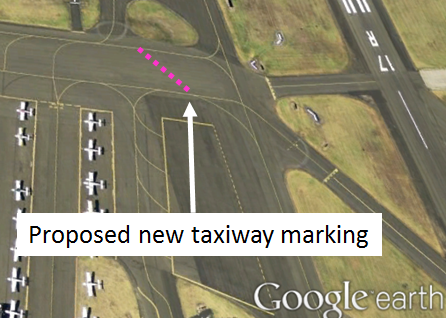What happened
On 29 January 2015, the student pilot of a Cessna 172S aircraft, registered VH-EOP, taxied for a solo training flight at Moorabbin Airport, Victoria. The student was cleared by air traffic control (ATC) to taxi via taxiway ‘A’ (Figure 1) to the holding point on taxiway ‘G’ for a departure from runway 13 Left (13L).
Figure 1: Extract of Moorabbin Airport En Route Supplement Australia entry
Source: Airservices Australia
As EOP passed the ‘A2’ taxiway, the right wingtip struck the rudder of another Cessna 172S aircraft, registered VH-EOT, which was stationary at the holding point for runway 13 Right (13R) on the ‘A2’ taxiway, and less than half a metre behind the marked holding line (Figure 2). The student pilot of EOP was unaware of the collision and continued to taxi to the holding point for runway 13L. A flight instructor on board EOT advised ATC of the collision and the controller directed the pilot of EOP to taxi back to the run-up bay. He was then advised of the collision and the instructor of EOT inspected both aircraft for damage. EOP was undamaged and EOT sustained minor damage to the rudder.
Pilot comments
The student pilot of EOP reported that he taxied on the yellow marked taxi line and assumed that this would provide adequate clearance from the stationary aircraft.
He subsequently had a taxi lesson focused on maintaining adequate clearance from other aircraft and obstacles, which he believed would be valuable training for all student pilots.
Figure 2: Moorabbin Airport, EOP taxi route and location of EOT
Source: Google earth
Safety action
Whether or not the ATSB identifies safety issues in the course of an investigation, relevant organisations may proactively initiate safety action in order to reduce their safety risk. The ATSB has been advised of the following proactive safety action in response to this occurrence.
Moorabbin Airport operator
As a result of this occurrence, the airport operator is taking the following safety actions:
Taxi line repaint
A work order has been raised to extend the left turn taxiway line to join the northern apron right side taxi line (Figure 3). This will increase the distance between an aircraft taxiing via taxiways ‘A’ and ‘G’ and an aircraft holding at the ‘A2’ holding point.
Figure 3: Taxiway line to be extended
Source: Google earth
Safety message
This incident highlights the importance of maintaining a good lookout when taxiing. Practice in taxiing an aircraft assists pilots to develop an awareness of where the extremities of the aircraft structure are going to track during ground manoeuvring.
Aviation Short Investigations Bulletin - Issue 40
Purpose of safety investigationsThe objective of a safety investigation is to enhance transport safety. This is done through:
It is not a function of the ATSB to apportion blame or provide a means for determining liability. At the same time, an investigation report must include factual material of sufficient weight to support the analysis and findings. At all times the ATSB endeavours to balance the use of material that could imply adverse comment with the need to properly explain what happened, and why, in a fair and unbiased manner. The ATSB does not investigate for the purpose of taking administrative, regulatory or criminal action. TerminologyAn explanation of terminology used in ATSB investigation reports is available here. This includes terms such as occurrence, contributing factor, other factor that increased risk, and safety issue. Publishing informationReleased in accordance with section 25 of the Transport Safety Investigation Act 2003 Published by: Australian Transport Safety Bureau © Commonwealth of Australia 2015
Ownership of intellectual property rights in this publication Unless otherwise noted, copyright (and any other intellectual property rights, if any) in this report publication is owned by the Commonwealth of Australia. Creative Commons licence With the exception of the Coat of Arms, ATSB logo, and photos and graphics in which a third party holds copyright, this publication is licensed under a Creative Commons Attribution 3.0 Australia licence. Creative Commons Attribution 3.0 Australia Licence is a standard form licence agreement that allows you to copy, distribute, transmit and adapt this publication provided that you attribute the work. The ATSB’s preference is that you attribute this publication (and any material sourced from it) using the following wording: Source: Australian Transport Safety Bureau Copyright in material obtained from other agencies, private individuals or organisations, belongs to those agencies, individuals or organisations. Where you wish to use their material, you will need to contact them directly. |





